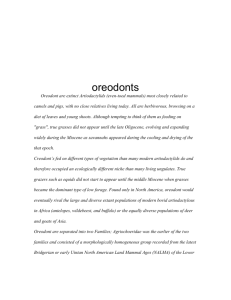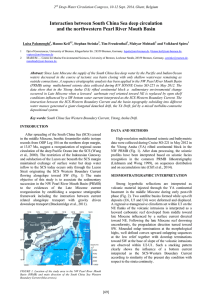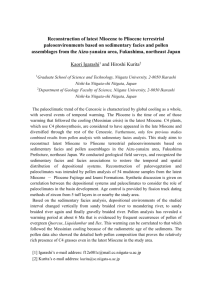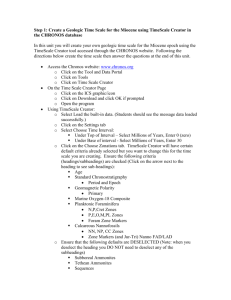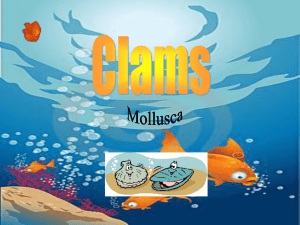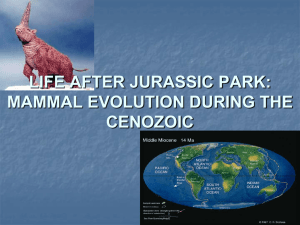Student Packet - Cloudfront.net
advertisement
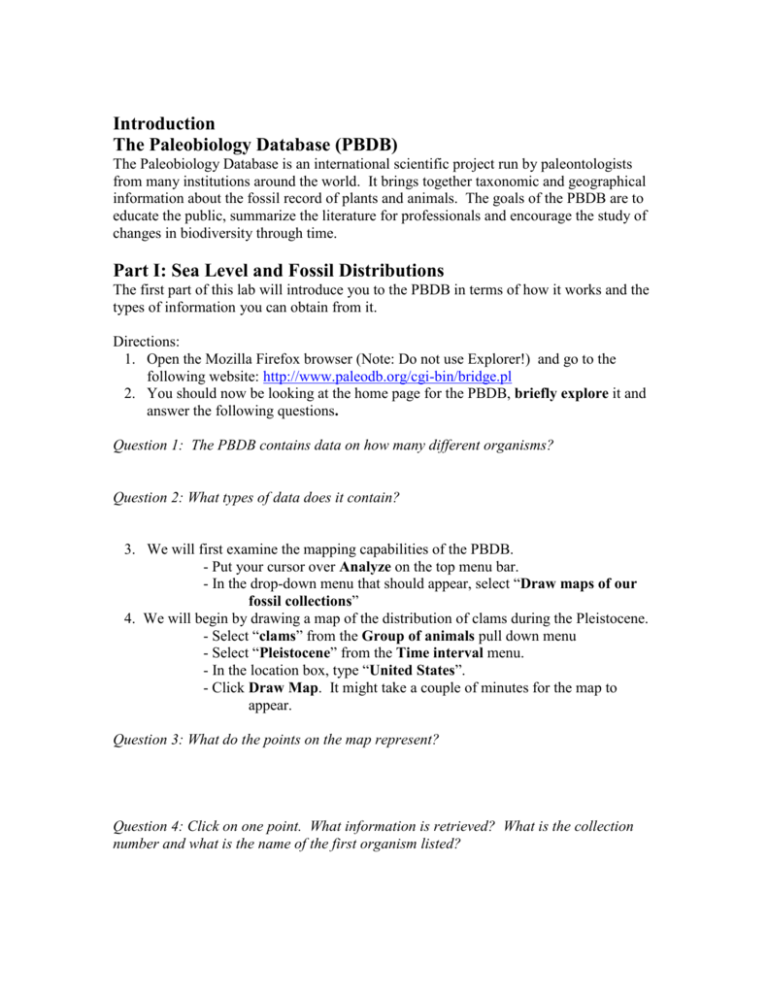
Introduction The Paleobiology Database (PBDB) The Paleobiology Database is an international scientific project run by paleontologists from many institutions around the world. It brings together taxonomic and geographical information about the fossil record of plants and animals. The goals of the PBDB are to educate the public, summarize the literature for professionals and encourage the study of changes in biodiversity through time. Part I: Sea Level and Fossil Distributions The first part of this lab will introduce you to the PBDB in terms of how it works and the types of information you can obtain from it. Directions: 1. Open the Mozilla Firefox browser (Note: Do not use Explorer!) and go to the following website: http://www.paleodb.org/cgi-bin/bridge.pl 2. You should now be looking at the home page for the PBDB, briefly explore it and answer the following questions. Question 1: The PBDB contains data on how many different organisms? Question 2: What types of data does it contain? 3. We will first examine the mapping capabilities of the PBDB. - Put your cursor over Analyze on the top menu bar. - In the drop-down menu that should appear, select “Draw maps of our fossil collections” 4. We will begin by drawing a map of the distribution of clams during the Pleistocene. - Select “clams” from the Group of animals pull down menu - Select “Pleistocene” from the Time interval menu. - In the location box, type “United States”. - Click Draw Map. It might take a couple of minutes for the map to appear. Question 3: What do the points on the map represent? Question 4: Click on one point. What information is retrieved? What is the collection number and what is the name of the first organism listed? Question 5: Where in the United States do these points appear? Why do you think this might be? 5. Now, using the back button on the browser, return to the map options page. - Change the time interval to “Cretaceous”, but leave “clams” and “United States” as they are. - Click Draw Map. Question 6: In what ways does this map differ from the previous map in terms of continent position and fossil distribution? Question 7: Where do clams occur in the United States during the Cretaceous? What inferences can you make about sea level and the environment during the Cretaceous? 6. Again, using the back button, return to the map options page. - This time draw a map for clams of the United States in the Devonian. Question 8: In what ways does this map differ from the previous maps? Question 9: Where do clams occur in the United States during the Devonian? Question 10: What do you think New York was like during the Devonian based upon your map? Part II: Biodiversity and Extinction 1. Now we are going to download data and create a diversity curve. - Using the menu at the top, place your cursor over Download - From the drop down menu, select “Collection, occurrence, or specimen data”. - When the Download request form appears, type “veneridae” in the Taxon box (This is the scientific name for a family of clams). - Click ‘Create dataset’. This may take a few minutes to process. 2. Once the dataset has finished downloading -Accept the terms of the PBDB -Scroll to the bottom of the page and click on “Generate diversity curves” - This will take you to another form. Leave all the default settings as they are and click on “Submit”. - The result will be a list of numbers, scroll down to the bottom of the page to where it says “The above diversity curve data”. - Right click on the link (raw_curve_data.csv) and go to “save link as”. Save this file to your desktop. 3. Now minimize (DON’T CLOSE) your web browser and go to the file you just saved. - Double click on it, Excel should automatically open it. - Highlight the columns of data called “Midpoint (Ma)” and “Sample genera”, and plot them as an XY scatter plot Question 1: Sketch your graph in the space below. Label and put a scale your axes. Question 2: What do the points on the graph mean? What does the x-axis mean? What does the y-axis mean? Question 3: What does this graph tell you about the evolution of these clams? (i.e. when did they originate, when were they most diverse, and if they went extinct, when?) 4. Now return your browser and the PBDB. - Repeat the above exercise, this time download data for the bivalve order Hippuritoida. (These were strange bivalves known as rudists that formed reefs like oysters. To see a picture of one, google “rudist”) - Now plot the data in the same way as you did above. Question 4: Sketch your graph in the space below; make sure you label and put a scale on your axes. Question 5: How does this graph look different from the first one you plotted? Question 6: Describe the evolution of rudists based on your graph. (i.e. when did they originate, when were they most diverse, and if they went extinct, when?). Part III: The Great American Interchange During the Cenozoic Era volcanic activity and mountain building along the western edge of North and South American plates created the Isthmus of Panama. The Isthmus of Panama is a land bridge that links North and South America. The Panama land bridge has had a significant effect on climate and species migration. The land bridge obstructed westward flow of the North Atlantic Ocean and is responsible for the Gulf Stream which provides warmer climates to northwestern Europe. Plants, animals and humans have migrated between North and South America thanks to the Isthmus of Panama. This section of today’s lab will explore the distribution odd-toed ungulates and then look more closely at horses. Odd-Toed Ungulates. An odd-toed ungulate is a hoofed terrestrial mammal that has an odd number of toes (i.e. horses, zebras, donkeys, rhinos, tapirs). 1. Construct a series of maps for the odd-toed ungulates for the Oligocene, Miocene, Pliocene, and Pleistocene Epochs. Question 1: On the maps printed below draw your ungulate distributions. Oligocene Miocene Pliocene Pleistocene Question 2: Briefly describe the geographic migration of ungulates through time. Based on these maps, when did the Isthmus of Panama land bridge form? Equidae. Equidae is also known as the “horse family”. This family includes horses as well as zebras and donkeys. 2. Construct a series of maps for Equidae (Taxon name: Equidae). - This time use the “more advance options” for mapping. - Click on this link beneath the Draw map button. - You will use the following time intervals: Middle Miocene, Late Miocene, Pliocene, and Pleistocene (You must type in the Epoch in the Time Interval box). - Choose a reconstruction date that falls within the Epoch you are mapping. (For example: the reconstruction date 30 Ma falls within the Oligocene Epoch. Question 3: On the maps printed below, draw your distributions for the horses. Oligocene Middle Miocene Late Miocene Pliocene Pleistocene Question 4: How long is the Miocene Epoch? What do the differences between the Mid Miocene and the Late Miocene distributions indicate about Equidae (horses) during this time interval? Question 5: How does the distribution of horses change from the Late Miocene to the Pliocene? Question 6: Based on your maps and descriptions of odd-toed ungulates (including horses), when was the land bridge between North America and South America complete? Question 6: Now look at the map you drew of horses in the Pliocene. Why do you think that there are so few fossil occurrences in central and northern Africa (Hint: think about both the physical and political setting of these areas)? Question 7: Why do you think that there are more fossils in North America and Europe than the rest of the world? Question 8: In addition to your answers above, what factors influence the distribution of fossils besides biological factors? This exercise was developed by Heather L.B. Wall, Jessica J. Terrien and Patrick D. Wall Department of Earth Sciences, Syracuse University, Spring 2008
